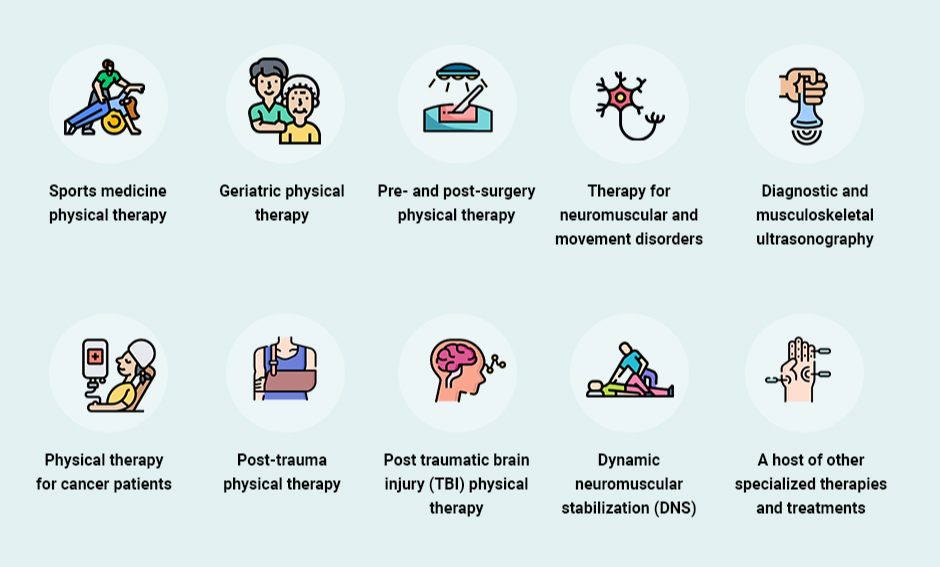When to See a Physical Therapist vs a Conventional Medical Doctor
Gone are the days when patients saw a single family doctor to treat all their healthcare issues. Today, conventional Western medicine, commonly called allopathic medicine, has been fractured into multiple specialties to treat specific systems of the body. But when it comes to treating musculoskeletal pain and dysfunction, an allopathic practitioner may not be your best option.
Learn the difference between allopathic medicine and physical therapy, and reasons for choosing physical therapy for pain, dysfunction, injuries and movement disorders.
What Do Allopathic Doctors Do?
Allopathic practitioners are medical doctors who are primarily trained to treat metabolic disorders, unless they opt for specialties like orthopedics or obstetrics. Diagnosis is primarily symptoms-based, confirmed with screening protocols and clinical exams.
The primary treatment modalities for allopathic doctors are:
When it comes to musculoskeletal pain and dysfunction, allopathic treatment options are limited, relying on drugs in the early phase of treatment to reduce pain and inflammation, and eventually resorting to surgery if the issue does not resolve itself.
Considering that almost every pharmaceutical drug on the market has serious side effects ranging from over-the-counter NSAIDs that cause liver damage, to narcotic pain medications that cause addiction and even death, many people prefer to steer clear of drugs altogether.
In addition, drugs do not heal musculoskeletal pain and dysfunction, they merely mask the symptoms. In an allopathic setting, any healing that takes place arises from the body’s own reparative mechanisms. When healing does not occur, surgery is often recommended, with its own serious risks, and no guarantee of successful outcomes.
What Does a Physical Therapist Do?
Physical therapists are human movement scientists who hold a Doctor of Physical Therapy (DPT) degree. They are trained to take a holistic approach to musculoskeletal pain and dysfunction.
Unlike conventional medical doctors who treat the body’s systems as independent entities. DPTs understand that all of the body’s systems are interdependent, and that problems arising in one area can impact other areas of the body. In that respect, DPTs are integrative practitioners.
DPTs typically steer their patients away from medications, and only recommend surgery as a last resort. They have access to a broad spectrum of alternative therapies that are known to promote healing.
Many physical therapists are specialists in their field. DPT specialities include:
Sports medicine physical therapy
Geriatric physical therapy
Pre- and post-surgery physical therapy
Therapy for neuromuscular and movement disorders
Diagnostic and musculoskeletal ultrasonography
Physical therapy for cancer patients
Post-trauma physical therapy
Post traumatic brain injury (TBI) physical therapy
Dynamic neuromuscular stabilization (DNS)
A host of other specialized therapies and treatments
A physical therapist works with you to help you move better, without pain or dysfunction. They help you to retrain your postural alignment, restore disrupted neural pathways between your brain and your muscles, improve balance and stability, enhance sports performance, and rehabilitate injuries.
Some people see a physical therapist on a regular basis for periodic tune-ups, to feel great and reduce their risks of falls and injuries.
Why Choose Physical Therapy?
Physical therapy taps into your body’s innate healing mechanisms to relieve pain, promote cellular progenesis, retrain errant muscle firing patterns, and restore pain-free functional movement. Unlike medications that temporarily numb pain and reduce inflammation, physical therapy aims to get to the underlying cause of your condition and fix it for good.
Many people assume that joint pain and stiffness, reduced mobility and loss of balance are inevitable consequences of aging. But that is only true if you ignore the signals your body is sending you and neglect to seek treatment. Physical therapy can help you move better at any age, for confidence, independence and improved quality of life.
How to Choose a Physical Therapist
It is important to understand that not all physical therapists provide the same level of care. Those whose client base stems from referrals from conventional doctors are often geared to post-trauma or post-surgery rehabilitation. Some work mostly with geriatric patients, and some with pediatrics.
You do not need a prescription or medical referral to see a physical therapist, although some insurance plans may require one if you want the insurer to pay for your therapy. Many physical therapists accept regular medical insurance without the need for a referral. Before you schedule your appointment, check your insurance coverage, and confirm that your chosen physical therapy office accepts your plan.
Before you make an appointment with a physical therapist, do some research online, to gather the following information:
Does the therapist’s website have a page that addresses your particular issue?
What academic credentials does the therapist have?
How many years has the therapist been practicing?
What special certifications or alternative therapies are listed on the website?
Who is the clinic’s target demographic?
Does the clinic treat athletes and physically active people?
What regenerative technologies are available at the clinic?
Does the clinic do on-site diagnostic imaging via ultrasound?
Does the website offer patient testimonials?
What do online review platforms say about the physical therapy practice?
Does the clinic offer personalized one-on-one treatment, or is their treatment approach a one-size-fits-all group therapy scenario?
Once you narrow down your options, give the clinic a call and ask questions, to get a feel for the type of customer service you can expect to receive. Steer clear of clinics whose tone does not make you feel welcomed and cared for.
Get the Best Physical Therapy in NYC
The 21st Century has ushered in a plethora of new technologies and treatment approaches that take physical therapy to a whole new level. Technological tools equip DPTs to accurately diagnose and treat patients based on quantitative data, taking the guesswork out of physical therapy, and opening the doors for more personalized care.
The clinic at NYDNRehab has some of the most advanced technologies available for diagnosing and treating musculoskeletal issues. Most of these technologies are rarely found in run-of-the-mill physical therapy clinics.
Our technological treatment toolbox includes:
High resolution diagnostic musculoskeletal ultrasonography
State-of-the-art 3D gait analysis technologies
Computer assisted rehabilitation environment (C.A.R.E.N)
AI-driven tools for assessment and rehabilitation
Shockwave therapy and other regenerative technologies
Blood flow restriction therapy
Ultrasound-guided dry needling
DD Robotech
KINEO intelligent loading system
Proteus motion
A broad range of other innovative therapies and tools
If you want to restore pain-free functional movement without drugs or surgery, contact NYDNRehab today, and see what a positive impact physical therapy can have on your overall quality of life.

































